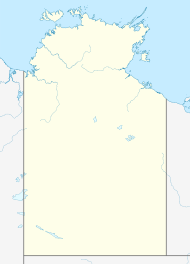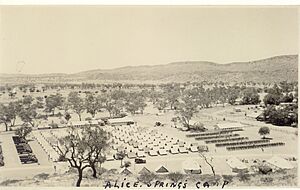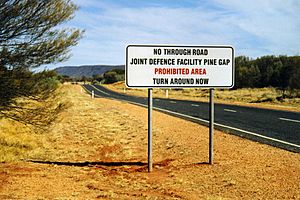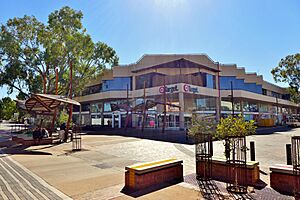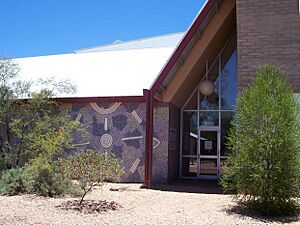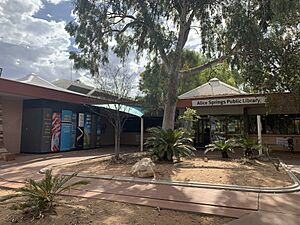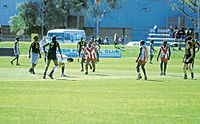Alice Springs facts for kids
Quick facts for kids Alice SpringsNorthern Territory |
|||||||||
|---|---|---|---|---|---|---|---|---|---|

View of Alice Springs from Anzac Hill, with MacDonnell Ranges and Heavitree Gap in the background
|
|||||||||
| Population | 25,912 (2021) | ||||||||
| • Density | 79.121/km2 (204.92/sq mi) | ||||||||
| Established | 1872 | ||||||||
| Postcode(s) | 0870-0872 | ||||||||
| Elevation | 545 m (1,788 ft) | ||||||||
| Area | 327.5 km2 (126.4 sq mi)(2011 urban) | ||||||||
| Time zone | ACST (UTC+9:30) | ||||||||
| Location | |||||||||
| LGA(s) | Alice Springs Town Council | ||||||||
| Territory electorate(s) |
|
||||||||
| Federal Division(s) | Lingiari | ||||||||
|
|||||||||
Alice Springs (Eastern Arrernte: Mparntwe) is a town in the Northern Territory, Australia. It is the third-largest settlement in the territory. The town is often called The Alice or simply Alice. It is located almost exactly in the geographic centre of Australia. Alice Springs is about the same distance from Adelaide and Darwin.
The name Alice Springs was given by surveyor William Whitfield Mills. He named it after Alice, Lady Todd, who was the wife of telegraph pioneer Sir Charles Todd.
The local original inhabitants are the Arrernte. They have lived in this Central Australian desert area for thousands of years. They call the area Mparntwe. As of June 2024, Alice Springs had about 33,990 people. This is about 10% of the Northern Territory's population.
The town is built along the Todd River, which is usually dry. It sits on the northern side of the MacDonnell Ranges. The area around Alice Springs is known as Central Australia or the Red Centre. It is a dry environment with several deserts. Alice Springs has big temperature changes. In summer, the average high is around 35.6°C. In winter, the average low is about 5.1°C.
Contents
History of Alice Springs
Who are the Traditional Owners?

The Arrernte are the traditional owners of the Alice Springs area. This includes the surrounding MacDonnell Ranges. They have lived here for at least 30,000 years. The traditional name for the town area is Mparntwe. This Arrernte word means "watering place". It refers to a waterhole in the Todd River.
The Arrernte language has five different dialects. Their country is full of mountains, waterholes, and gorges. These natural features create many different habitats. Arrernte stories say that the landscape was shaped by special caterpillars and wild dogs. Important traditional sites include Emily Gap and ANZAC Hill.
How European Settlers Arrived
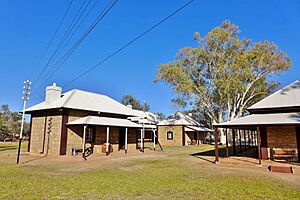
In 1861–62, John McDouall Stuart explored Central Australia. He found a route from the south to the north of the continent. Ten years later, a repeater station was built for the Australian Overland Telegraph Line (OTL). This line connected Adelaide to Darwin and Great Britain. The OTL was finished in 1872. It followed Stuart's route and allowed people to settle in the interior.
The Alice Springs Telegraph Station was built near a waterhole in the Todd River. W.W. Mills named this waterhole Alice Springs. He named it after Alice, the wife of Sir Charles Todd. Sir Charles Todd was important in building the OTL. The nearby settlement was called Stuart. On August 31, 1933, it was renamed Alice Springs. The Todd River and Charles River, which meet near the station, were also named after Sir Charles.
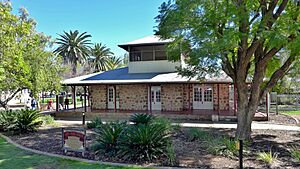
More European settlers came after gold was found at Arltunga in 1887. This was about 100 km east of Alice Springs. The town's first main building was the Stuart Town Gaol, built in 1909. At that time, fewer than 20 Europeans lived there. The first aircraft landed in 1921. Central Australia's first hospital, Adelaide House, was built in 1926. The town's European population grew when the train line reached Alice Springs in 1929.
Before the railway, goods were transported by camel trains. These were operated by "Afghan" cameleers. Many cameleers moved to Alice Springs when the railway arrived. They transported goods from the train station to other settlements. A gold rush in Tennant Creek in 1932 helped the town's economy.
Father Percy Smith started St John's Hostel in 1941. It provided a home for Aboriginal and non-Aboriginal children from remote areas. They could attend school in Alice Springs. The hostel continued until the 1970s.
Alice Springs During World War II
World War II changed Alice Springs a lot. Before the war, it was a small, isolated place with fewer than 500 people. During the war, it became a very busy military base. It was a stopover for the four-day trip to Darwin. The railway in Alice Springs was used for military operations. Many soldiers were stationed there or passed through.
When Darwin was threatened by Japanese forces, its sea routes were cut off. Many civilians and government records from Darwin moved to Alice Springs. Alice Springs became the temporary capital of the Northern Territory during the war. When Darwin was bombed, many soldiers and their equipment moved to Alice Springs.
About 8,000 soldiers were stationed in Alice Springs at one time. Close to 200,000 people passed through the town. After the war, the military camps left, and the population dropped. But Alice Springs became famous after so many people, including American General Douglas MacArthur, visited. The war also left behind many buildings, like the Totem Theatre. The Australian Army set up a hospital. The Royal Australian Air Force built Seven Mile Aerodrome. The road to Larrimah was sealed, and the water supply and rail head were improved.
After World War II
In the 1960s, Alice Springs became important for defence. This was because of the Pine Gap base. It is a joint US/Australian satellite monitoring base. About 700 workers from both countries work there.
Today, tourism is the main industry. Alice Springs is about 1200 km from the ocean. It is 1500 km from the nearest big cities, Darwin and Adelaide. Alice Springs is the middle point of the Adelaide–Darwin Railway. The first passenger train arrived in Darwin from Adelaide on February 4, 2004.
Modern Alice Springs
The modern town of Alice Springs mixes European and Aboriginal cultures. The main area is the Todd Mall. It has many Aboriginal art galleries and hosts community events. In February 2024, a new information centre for AIATSIS Central Australia opened there.
Alice Springs' desert lifestyle has led to unique events. These include the Camel Cup and the Henley-on-Todd Regatta.
Important Buildings
Alice Springs has many historic buildings. These include the Overland Telegraph Station and the Old Courthouse. Adelaide House was the town's first hospital. It was built in 1926 by Rev. John Flynn. He founded the world's first flying doctor service. It was also where the first successful portable wireless radio experiment happened. Today, it is a museum.
Alice Springs is an important tourist hub and service centre. It has hotels, a convention centre, and many attractions.
Geography and Climate
The area around Alice Springs is dry grassland. It includes the MacDonnell Ranges. These ranges have hiking trails and swimming holes. The 223 km Larapinta Trail follows the West MacDonnell Ranges. It is a famous walking trail.
The Simpson Desert is southeast of Alice Springs. It is a large wilderness area with red sand dunes and rock formations.
What is the Climate Like?
Alice Springs has a hot desert climate. Summers are very hot and a bit moist. Winters are short, very dry, and mild. The town is just south of the Tropic of Capricorn. It sits on the northern side of the MacDonnell Ranges. Alice Springs is in Central Australia, also called the Red Centre. This is a dry environment with several deserts.
The average yearly rainfall is about 285.9 mm. This makes it a desert climate because of how quickly water evaporates. Rainfall can vary a lot each year. For example, 741 mm fell in 2001, but only 198 mm fell in 2002. The most rain in one day was 204.8 mm on March 31, 1988.
Temperatures in Alice Springs change widely. In summer, the average high is in the mid-30s Celsius. In winter, the average low can be 5.5°C. It freezes about 12 times a year. The town is about 545 meters high, which helps make winter nights cool. The hottest temperature ever recorded was 47.5°C in 1891. The coldest was -7.5°C in 1976. This is the lowest temperature ever recorded in the Northern Territory.
People of Alice Springs
| Historical population | ||
|---|---|---|
| Year | Pop. | ±% |
| 2001 | 23,384 | — |
| 2006 | 21,622 | −7.5% |
| 2011 | 24,208 | +12.0% |
| 2016 | 23,726 | −2.0% |
| 2021 | 24,855 | +4.8% |
| Source: ABS (Urban Centres and Localities) | ||
In 2021, the Alice Springs Urban Area had 24,855 people.
- Aboriginal and Torres Strait Islander people made up 21.2% of the population.
- 66.7% of people were born in Australia. Other birthplaces included India (3.9%), New Zealand (3.3%), and the United States (2.7%).
- 67.6% of people spoke only English at home. Other languages included Arrernte (1.8%) and Malayalam (1.8%).
- About half the population (51.6%) said they had no religion. Christianity was the largest religious group (41.1%).
Aboriginal Population
Alice Springs is a main centre for Central Australia. Many Aboriginal people from the region visit the town for services. Aboriginal residents live in suburbs, special communities called town camps, or on small family outstations nearby.
The traditional owners are the Central Arrernte people. Since Alice Springs is the largest town in Central Australia, many other Aboriginal languages are spoken there. These include Warlpiri, Warumungu, and Pitjantjatjara.
People from Other Countries
Americans have lived in Alice Springs since 1954. This was when the United States Air Force Detachment 421 was set up. It is part of a joint American–Australian project. This unit brings American families to live in Alice Springs. In 1995, the town council gave Detachment 421 "Freedom of Entry" to Alice Springs.
Since the 1970s, most Americans in Alice Springs are linked to Pine Gap. This is a joint Australian-US satellite tracking station. It is about 19 km southwest of Alice Springs. About 700 Americans and Australians work there. Currently, 2,000 people in the Alice Springs area have American citizenship. They celebrate American holidays like the 4th of July.
Alice Springs also has small communities of other cultures. These include Vietnamese, Chinese, Thai, Sudanese, and Indian people. Their presence has led to many restaurants serving traditional foods.
Visitors and Temporary Residents
Alice Springs has many visitors and temporary residents. This group includes tourists from Australia and other countries. It also includes Aboriginal Australians visiting from nearby communities. Many Australian or international workers come for short-term jobs. These jobs are often in mining, healthcare, or law enforcement.
Foreign tourists usually pass through on their way to Uluru-Kata Tjuta National Park. Australian tourists often come for events like the Masters Games or the Finke Desert Race. These events can make the town's population grow by thousands in just a few days.
Economy of Alice Springs
Alice Springs started as a service town for the farming industry. The railway helped its economy grow. Today, the town serves a large region of 546,046 square kilometers. This region has mining and farming communities. It also includes the Pine Gap defence facility and tourist spots like Uluru-Kata Tjuta National Park.
The biggest employer in Alice Springs is the Northern Territory Government. Many people work in government, schools, and the Alice Springs Hospital. Tourism is also very important. About 4% of workers are in accommodation services. Many tour companies operate from Alice Springs. They offer tours to Uluru and the MacDonnell Ranges.
The Royal Flying Doctor Service also has a dispatch centre here.
Education in Alice Springs
Education in the Northern Territory is managed by the Department of Education and Training. They work to improve education for all students, especially Indigenous students.
Alice Springs has public and private schools for local and international students. The Alice Springs School of the Air teaches students in remote areas. There are 10 private schools. Yirara College is a boarding school for about 200 Aboriginal high school students.
The Alice Springs Campus of Charles Darwin University offers college and university courses. The Centre for Appropriate Technology helps Aboriginal people improve their lives in remote communities.
Fun Things to Do and Culture
Events and Festivals
Parrtjima – A Festival in Light
Parrtjima – A Festival in Light happens for 10 days each April. It takes place in the desert outside Alice Springs. The name Parrtjima means "shedding both light and understanding" in the local Arrernte language. The festival celebrates the world's oldest cultures using modern technology. It includes light shows, art, storytelling, and Aboriginal culture. The Alice Springs Desert Park and Araluen Arts Centre host workshops, music, dance, and films. The festival is free and has happened every year since 2016.
Other Events
The Todd Mall hosts many Aboriginal art galleries and community events. Alice Springs' desert life has inspired unique events. These include the Alice Desert Festival, the Red Centre NATS, and the Blacken Open Air music festival. Other events are the Camel Cup, the Henley-on-Todd Regatta, the Beanie Festival, and the Finke Desert Race. The Finke Desert Race is a 460 km round trip from Alice Springs to Aputula (Finke).
Arts and Entertainment
Galleries and Museums
Alice Springs has many local and Aboriginal art galleries. Many galleries show Indigenous Australian art. The trade in Aboriginal art grew after the painting movement started at Papunya. Central Australia is home to famous Aboriginal artists.
The Museum of Central Australia has important natural history and historical items. The Araluen Centre for Arts and Entertainment hosts ballets, orchestras, and local shows.
The Women's Museum of Australia is at the Old Alice Springs Gaol. It tells stories of women from across Australia. The Old Timer's Traeger Museum has items from early residents. It also shows how European and Aboriginal cultures mixed.
Library and Collections
Alice Springs has the Alice Springs Public Library, also known as the Nevil Shute Memorial Library. It has books and e-resources. It also has special collections about Central Australia. These include Aboriginal language resources and cultural heritage information. The library has digital copies of the Centralian Advocate newspaper from 1947 to 2015. It also has over 6000 historical images.
Library & Archives NT also has offices in Alice Springs. They hold historical records about Central Australia. AIATSIS Central Australia provides access to online resources about Aboriginal and Torres Strait Islander studies.
Outdoors and Sports
Fun outdoor activities include hiking in the MacDonnell Ranges. You can also drive four-wheel-drive tracks at Finke Gorge National Park.
Parks and Gardens
The Alice Springs Desert Park teaches visitors about the desert environment. The Olive Pink Botanic Garden is a dry climate garden near the town centre. It is named after Olive Pink, an anthropologist and artist. The Alice Springs Reptile Centre is in the town centre.
Sports in Alice Springs
Alice Springs has many popular sports. These include Australian rules, baseball, basketball, boxing, cricket, football, golf, hockey, rugby, and tennis.
Australian rules football is very popular. The Central Australian Football League has several teams. The local stadium, Traeger Park, can hold 10,000 people. It hosts pre-season AFL games.
Association football (soccer) is popular with younger people and amateur adults. There is also an all-African league. Both Rugby union and Rugby league are played. The local rugby union competition has four teams. The local rugby league competition has four senior teams.
Cricket is popular and played at Traeger Park. The Imparja Cup Cricket Carnival brings Indigenous teams from all over Australia.
Baseball has been played since the 1950s. The Alice Springs Baseball Association organizes games for youth and adults. Players can compete in national Little League competitions.
The Alice Springs Golf Course is an 18-hole course. It was opened in 1985. Adam Scott, a famous golfer, won a championship there in 1997.
The Traeger Park complex also hosts tennis, boxing, swimming, and other sports.
A unique event is the Henley-on-Todd Regatta. It is a sand river race with bottomless boats. It is the only dry river regatta in the world. Another unusual event is the Camel Cup. It is held in July and features camel races.
The annual Finke Desert Race is held every year. It is a tough off-road race from Alice Springs to the Finke community and back. The race is about 500 km long. It attracts many spectators and about 500 competitors. This makes it the biggest sporting event in Alice Springs.
Drag racing happens at the Alice Springs Inland Dragway. In September 2017, an incident occurred during the Red CentreNATS competition.
Alice Springs is also home to the Arunga Park Speedway. This is a 402-meter dirt oval track. It hosts car and motorcycle races.
Media in Alice Springs
Alice Springs has local and national radio and TV services. The ABC provides five radio stations. These include local radio ABC Alice Springs and national networks. Commercial radio stations are 8HA and Sun 96.9.
Alice Springs is home to Australia's largest Indigenous media company, the Central Australian Aboriginal Media Association (CAAMA). CAAMA has a radio station, music label, and TV/film company. It promotes Indigenous talent.
Five TV channels operate in Alice Springs. These include commercial stations and government-owned ABC TV and SBS TV. Imparja Television operates from studios in Alice Springs. It shows programs from the Nine Network.
From June 2020 to August 2023, Alice Springs did not have a local newspaper. The Centralian Advocate closed after 76 years. In August 2023, a new weekly newspaper, The Centralian Today, started publishing.
Town Infrastructure
Transport
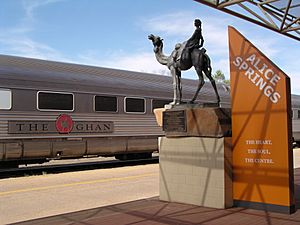
The Alice Springs railway station is served by The Ghan. This train travels weekly from Adelaide to Darwin.
The original narrow gauge railway opened to Alice Springs in 1929. It was replaced in 1980 by a standard gauge line. This line was extended to Darwin in 2004.
Greyhound Australia runs bus services from Alice Springs to Adelaide and Darwin. Local bus services are operated by CDC Northern Territory.
The Stuart Highway runs north from Adelaide to Darwin through Alice Springs. It is the Northern Territory's most important road. Alice Springs is about 1530 km from Adelaide and 1498 km from Darwin.
Flights from Alice Springs Airport go to Adelaide, Brisbane, Darwin, Melbourne, and Sydney. These flights are operated by various airlines.
Alice Springs is also a base for the Royal Flying Doctor Service.
Sister Cities
See also
 In Spanish: Alice Springs para niños
In Spanish: Alice Springs para niños


